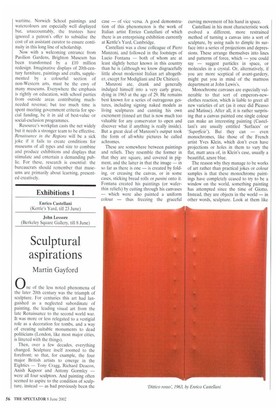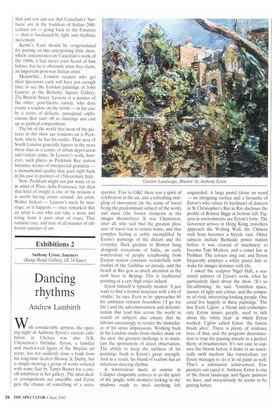Exhibitions 1
Enrico Castellani (Kettle's Yard, till 23 June) John Lessore (Berkeley Square Gallery, till 8 June)
Sculptural aspirations
Martin Gayford
0 ne of the less noted phenomena of the later 20th century was the triumph of sculpture. For centuries this art had languished as a neglected subordinate of painting, the leading visual art from the late Renaissance to the second world war. It was more or less relegated to a vestigial role as a decoration for tombs, and a way of creating suitable monuments to dead politicians (London, like most major cities, is littered with the things).
Then, over a few decades, everything changed. Sculpture itself zoomed to the forefront; so that, for example, the four major British artists to emerge in the Eighties — Tony Cragg, Richard Deacon, Anish Kapoor and Antony Gormley — were all four sculptors. And painting often seemed to aspire to the condition of sculpture, instead — as had previously been the case — of vice versa. A good demonstration of this phenomenon is the work of Italian artist Enrico Castellani of which there is an enterprising exhibition currently at Kettle's Yard, Cambridge.
Castellani was a close colleague of Piero Manzoni, and followed in the footsteps of Lucio Fontana — both of whom are at least slightly better known in this country than he is (although we know disgracefully little about modernist Italian art altogether, except for Modigliani and De Chirico).
Manzoni ate, drank and generally indulged himself into a very early grave, dying in 1963 at the age of 29. He remains best known for a series of outrageous gestures, including signing naked models as living sculptures and canning his own excrement (tinned art that is now much too valuable for any conservator to open and discover what if anything is really inside). But a great deal of Manzoni's output took the form of all-white pictures he called achromes.
These are somewhere between paintings and reliefs. They resemble the former in that they are square, and covered in pigment, and the latter in that the image — in so far as there is one — is created by folding, or creasing the canvas, or in some cases, sticking bread rolls or panini onto it. Fontana created his paintings (or waferthin reliefs) by cutting through his canvases — which were also painted a uniform colour — thus freezing the graceful
curving movement of his hand in space.
Castellani in his most characteristic work evolved a different, more restrained method of turning a canvas into a sort of sculpture, by using nails to dimple its surface into a series of projections and depressions. These arrange themselves into lines and patterns of force, which — you could say — suggest particles in space, or molecules in a crystal. Or, alternatively, if you are more sceptical of avant-gardery, might put you in mind of the mattress department at John Lewis's.
Monochrome canvases are especially vulnerable to that sort of emperors-newclothes reaction, which is liable to greet all new varieties of art (as it once did Picasso and Matisse). After all, it is rather surprising that a canvas painted one single colour can make an interesting painting (Castellani's are usually entitled 'Surfaces' or `Supelficie). But they can — even monochromes, like those of the French artist Yves Klein, which don't even have projections or holes in them to vary the flat, matt area of, in Klein's case, usually a beautiful, azure blue.
The reason why they manage to be works of art rather than practical jokes or colour samples is that these monochrome paintings have completely ceased to try to be a window on the world, something painting has attempted since the time of Giotto. Instead, they are objects in the world — in other words, sculpture. Look at them like that and you can see that Castellani's 'Surfaces' are in the tradition of Italian 20thcentury art — going back to the Futurists — that is fascinated by light and rhythmic movement.
Kettle's Yard should be congratulated for putting on this enterprising little show, which concentrates on Castellani's work of the 1960s. I had never even heard of him before, but he is obviously what they claim, an important post-war Italian artist.
Meanwhile, London readers who get their Spectators early will have just enough time to see the London paintings of John Lessore at the Berkeley Square Gallery, 23a Bruton Street. Lessore is a painter of the other, post-Giotto variety, who does create a window on the world — in his case by a series of delicate, perceptual explorations that start off as drawings and end up as painted compositions.
The bit of the world that most of the pictures in this show are windows on is Peckham, where he has his studio. That area of South London generally figures in the news these days as a centre of urban deprivation and violent crime. In Lessore's work, however, such places as Peckham Rye station becomes scenes of unexpected grandeur — a monumental quality that goes right back in his case to painters of 15th-century Italy.
Now, Peckham might not put many of us in mind of Piero della Francesca, but then that kind of insight is one of the reasons it is worth having artists around. An artist, Walter Sickert — Lessore's uncle by marriage, as it happens — once remarked that an artist is one who can take a stone and wring from it pure attar of roses. That remains true, and true of all manner of different varieties of art.























































































 Previous page
Previous page